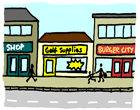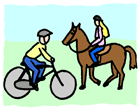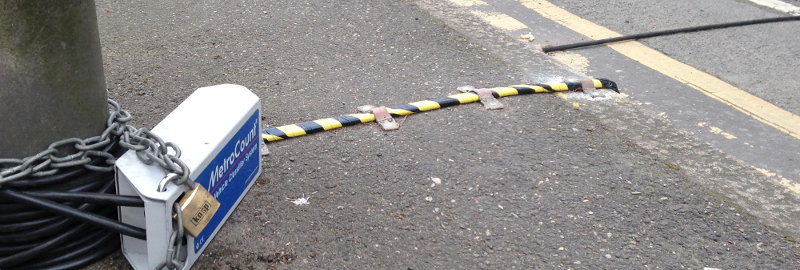How is a speed limit chosen? The default 30, 60 or 70 might not be right for all sorts of reasons. But if it's not, how do engineers choose a new number to put on the signs?
There's a single document that explains almost all there is to know on this subject. Its innocuous name barely hints at its influence over speed and safety policy on our roads. It's called DfT Circular 01/2006 and it tells highway authorities nationwide how to go about setting a speed limit.
The document that changed nothing and everything
DfT Circular 01/2006 didn't win any literary awards and it's not widely read outside council highways departments. It's an advisory note circulated by the Department for Transport, so it didn't follow any debate in Parliament and its issue wasn't marked in the press. And why should it? It's the latest in a series of similar documents, replacing Circular Roads 01/93, which said many of the same things in roughly the same terms. It offers updated advice on speed limits in light of changes that have happened since 1993. It didn't really change anything.
It also changed everything. Many countries set speed limits using the "85th percentile", an idea that means that the top speed of 85% of the vehicles on a road should be considered legal. Using it as a basis for a speed limit has clear benefits: the limit has been set by popular opinion of drivers, so it should be based on the judgement and experience of a broad cross-section of the motoring public, and it ends up requiring little enforcement action as the vast majority of drivers will naturally comply with it.
Until 2006, the UK was in the 85th percentile club along with many other developed countries. DfT Circular 01/2006 changed that, instead requiring that "mean speeds should be used as the basis for determining local speed limits". The mean speed is not the same as the 85th percentile — in fact it can be quite different, and is almost certain to be lower.
The DfT made this change because of research showing that every reduction of the average speed by 1mph led to a reduction of accidents by 5%. Using mean speeds gently pushes limits down a little, which theoretically will skim a little off the accident rate. They also claim that they are "easier for road users themselves to understand". Certainly one argument against the 85th percentile is that it asks only what speed motorists think is appropriate, and not any other users of the road.
The circular also suggests that local authorities should review all their A- and B-roads against the guidance in the document and conduct ongoing, rolling reviews of their road networks in order to make sure speed limits are kept up to date. That's innocuous enough, but the guidance for selecting a limit has changed, and some local authorities seem to have interpreted this as a call for broad reviews to apply the new methodology.
Most of DfT Circular 01/2006 is a bland continuation of the advice that has always been offered to highway authorities. But those few modifications may be surprisingly important. So how does it work?
Pick a number, any number
Let's set a speed limit for a road and see what it involves.
Our guidance from Whitehall says that we should aim to "provide a consistent message between the road geometry and environment, and for changes in speed limit to be reflective of changes in the road layout and characteristics". This is a multiple-choice question with six possible answers: 20, 30, 40, 50, 60 or 70. We start by asking some questions.

What's around here?
Is this road rural or urban? Are there houses, driveways, shop frontages? Is there a school? Is the surrounding area heavily built-up, or are we near the edge of town?

What is this road for?
The road's function is next. Who uses it? Is it a main road with high volumes of through traffic, or a local road, or just a street or cul-de-sac? This should suggest possible limits that might be right, and rule out others.

How is the road laid out?
The geometry of the road will tell us a lot. Is it wide and open or narrow and twisting? Its width, corners, junctions and private accesses are important factors. Sightlines and obstructions to forward visibility will count for a lot. A comparison with standards in the Design Manual for Roads and Bridges, which instructs engineers how to design roads for travel at different speeds, might help.

Who's on the road?
It's all very well looking at the cars and lorries, and work out how fast they can safely take the corners. Who else is here? Are there large numbers of pedestrians or is this a well-used cycle route? Is there a retirement home on one side of the road and a golf course on the other, with large volumes of elderly people in distractingly lurid tartan clothing wanting to cross?

What happened here?
Accident reports from the last few years will build a picture of where the problems are and whether excessive speed is a factor. This data — for "KSI" or "killed and seriously injured" accidents — is routinely gathered, but what matters most is whether it's intelligently analysed and interpreted. It might indicate hazards that aren't immediately obvious, or it might suggest that the usual traffic speed is making accidents — when they happen — far worse than they would otherwise be.

How fast are people travelling?
The final piece of the jigsaw is a survey that will tell us the speed of existing vehicles and get us that magical mean speed for the road. This is usually done automatically, commonly using pairs of pneumatic pipes bolted to the road surface and connected to a data logger at the roadside.
Together, these factors should point us towards just a couple of possibilities. Drivers are not stupid (well, most of them aren't) and the usual traffic speed is hopefully in the same ballpark as the speed that would seem appropriate given the road's layout and surroundings.
Where there's a difference, it usually means that there are factors to consider that drivers aren't noticing. Often those issues are visible with an analysis of accident data, such as an unusual frequency of accidents involving pensioners in garish leisurewear.
Finally, to help us decide, the DfT suggests the places where different limits are appropriate.
| Urban areas | |
|---|---|
| Limit | Suggestion |
 |
Town centres, residential areas, around schools. |
 |
Standard limit in built-up areas with development on both sides of the road. |
 |
Higher quality suburban roads or those on the outskirts. Few vulnerable road users. Good width and layout, buildings set back from the road, adequate footways and crossing places. |
 |
Dual carriageway ring or radial routes, bypasses which have become partially built up. Little or no roadside development. |
| Rural areas | |
| Limit | Suggestion |
 |
The norm in villages. |
 |
Roads with many bends, junctions or accesses, substantial development, a strong environmental or landscape reason, or considerable numbers of vulnerable road users. |
 |
Lower quality A and B roads with a relatively high number of bends, junctions or accesses, and lower quality unclassified roads. |
 |
High quality strategic A and B roads with few bends, junctions or accesses; only the best unclassified roads. |
By now the right limit for our road should be abundantly clear. Let's make it real.
Laying down the law
We'll need to make an order for our new speed limit to have effect. Handily, there's no uncertainty about this process thanks to another document, enticingly called The Local Authorities' Traffic Orders (Procedure) (England and Wales) Regulations 1996. There are similar documents for Scotland and Northern Ireland.
To make an order we need to go through several steps.
- Consult the emergency services, bus operators, the Freight Transport Association, the Road Haulage Association, and other bodies (perhaps other local authorities) who may be affected. We don't actually have to ask the police, but it's usually a good idea to see what they think too.
- Publish at least one detailed notice about the new limit in a newspaper that is sold in the local area and in the London Gazette. We also need to send details to the people we consulted, and deposit the documents somewhere the public can inspect them. Surprisingly, though, we don't have to post notices anywhere nearby, or publicise it on the local authority's website, or deliver publicity to homes and businesses nearby.
- Consider any objections that have been received. If we agree with any of the objectors, modify the order. It might be necessary to inform people who will be affected by these changes.
- Make the order, by producing the legal documentation, publishing its details in a local newspaper and informing any objectors.
Finally, road signs need to go up to indicate the new limit. Usually this happens in the weeks before the order is published (even if there are objections, it's very unlikely the order will be cancelled). Until they're needed, they are usually hidden from view using the least technical weapon in the highway engineer's arsenal, a black bin bag.
Signage isn't always a straightforward job. New terminal signs will be needed at the edges of the new limit, but where it joins an existing limit that's the same, the signs between them will need to be removed. If the effect of the order is to return the road to being restricted or derestricted, it might be necessary to remove signs rather than put them up.
Most new speed limits are followed up by further surveys to see what effect they have. If it's not being obeyed, further interventions may be needed — works to alter the road, for example, so that drivers read it correctly, or even traffic calming measures. Vehicle-activated signs are sometimes used to remind motorists of the speed they're travelling and show them smiley faces. And if all else fails, there's always enforcement — by police or by camera.
Ideals and ideology
Speed limits are changed for all sorts of reasons. One of the most common is to address a pattern of accidents on a particular stretch of road. They can also be changed in ongoing reviews of limits, or because a road becomes built-up, or to bring a road into line with others nearby whose limits have also been changed. Sometimes the demands of local residents force a change of limit.
Today, perhaps more than in the past, there's a certain level of discontent with the setting of speed limits. Certainly, in the last 25 years, the proportion of the road network covered by specific local limits has increased noticeably. Different authorities interpret official advice in different ways, and since the newest guidance was published in 2006, some local authorities have been meticulous in carrying out wide-scale reviews of their road networks as it recommends.
Criticism is evident among professional drivers, on web forums for driving enthusiasts and sometimes in local press, and it seems to centre around a perceived shift from speed limits guiding drivers to select a suitable speed to forcing a reduction in traffic speeds. The language is emotive: councils are typically "anti-car", and innocent speed limits are usually "slashed". In part this may be linked to the change from using the 85th percentile to using mean traffic speeds.
British drivers are, of course, taught to "read" the road so that they can judge a safe travel speed. Motorists are assumed to be intelligent and responsible, driving to the conditions and not blindly powering along every road as fast as the law will allow, but it's a double-edged sword. When the speed limit doesn't match the driver's perception and judgement, they will naturally select their own speed — which may be higher than the number on the sign. In a nation where drivers are expected to think for themselves, simply changing the rules and expecting blind obedience won't always work.
Some limits are not introduced because of the conditions on the road, but rather for other ends. Some are political. In 2000, when Transport for London assumed control of London's major roads, one of their first acts was to declare that there was no need for city traffic to travel at high speed, and capped speed limits on their road network to 50mph. Some of the roads whose limit was cut in that programme were designed for 60 or 70, and the limit change was very unlikely to have taken the specific conditions on any one road into account.
Similarly, some local authorities have decided to reduce most or all their urban roads to 20mph — in some cases, such as the London Boroughs that did this, the result has been virtually the council's entire highway portfolio having a lower limit applied. Again, these limits rarely take into account the conditions of any one specific road, and the result can be that some roads are left with speed limits that feel, to a driver, quite different to the speed they judge to be safe.
Limits such as these might be at odds with other districts where a different council, adopting a different policy, might choose higher or lower limits on similar roads. That's an unavoidable consequence of allowing local authorities to choose their own limits, and it may also be a consequence of speed limit guidance that is open to a certain amount of interpretation. It's also, potentially, a risk because setting speed limits that don't match drivers' perception can dilute respect for limits in general.
For all these reasons, speed limits are changing in the UK, and the trend is overwhelmingly that they go down and not up. That may be a problem, if you subscribe to the view of many drivers, that reduced limits and increasing variation on roads of a similar standard make travel slower and the rules less consistent. Or it may be welcome: lower limits are widely supported by people like cycling associations (who tend to approve of urban 20 limits) and the CPRE (who support a blanket 50 limit on rural roads). They argue that lower speed limits help to reduce the dominance of motor traffic over other road users and have environmental benefits.
Whatever your view, the rules are the rules, and there's no indication that they will change any time soon. So, as speed limits are reviewed and replaced, keep your eyes on the signs — otherwise you may earn yourself a fine.



